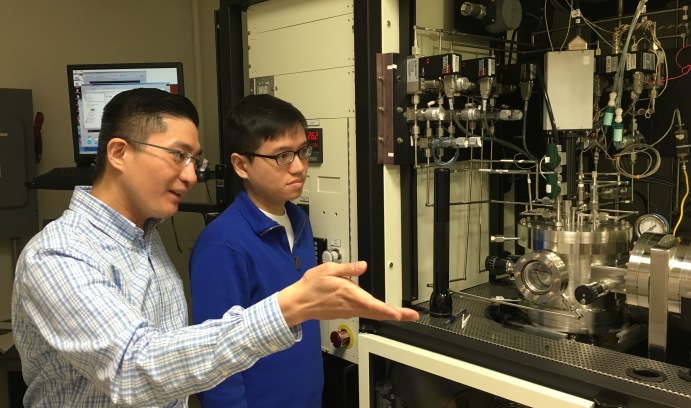Toward more vibrant LEDs

Chee-Keong Tan (right) and Nelson Tansu inspect the MOCVD (Metal-Organic Chemical Vapor Deposition) reactor system in Lehigh’s Center for Photonics and Nanoelectronics. (Photo courtesy of Chee-Keong Tan)
Chee-Keong Tan has not yet completed his Ph.D. in electrical engineering, but he has already made his mark in the field of solid state lighting and the light-emitting diodes (LEDs) that outperform fluorescent and incandescent lighting in energy efficiency.
Tan is author or coauthor of more than 50 articles published in refereed technical journals and conference proceedings, including Nature Nanotechnology and Scientific Reports of the Nature publishing group. Many of the articles discuss the unique optoelectronic properties of the novel semiconductor materials he has discovered, and their potential for improving the light-generating efficiency of LEDs by attracting electrons and holes in the active region.
One of those materials—a compound of arsenic, gallium and nitrogen known as dilute-As GaNAs—is believed to have advantages over the conventional indium gallium-nitride (InGaN) used for visible light emission. Tan and other researchers have proposed diluting GaN with small amounts of arsenic to boost the intensity of all three colors, especially the red.
Last year, Tan received an Optics and Photonics Education Scholarship from SPIE, the international society for optics and photonics. In February, after winning a poster competition, Tan and six other students in the United States were invited to give a presentation to the U.S. Department of Energy’s 2016 Solid State Lighting R & D Workshop in Raleigh, North Carolina. Tan’s research was cited for its novelty and significance.
In his research, Tan employs first-principle calculations and advanced band modeling to investigate the band structures and the electronic and optical properties of materials. He designs novel semiconductor materials and nanostructures that enhance LED performance. In one project, he couples dilute-As GaNAs with InGaN to form a unique active region structure for visible light emission. This brings electrons and holes into closer proximity, enabling them to recombine more efficiently.
In an article published in January in Scientific Reports, Tan reported that the addition of a layer of dilute-As GaNAs at the quantum level showed “high potential…for achieving high-efficiency nitride-based LEDs in the red spectral regime.”
The article, titled “InGaN/Dilute-As GaNAs Interface Quantum Well for Red Emitters,” was coauthored with Nelson Tansu, Tan’s adviser, and with Wei Sun and Damir Borovac ’15, who are Ph.D. candidates in electrical engineering. Tansu is the Smith Family Endowed Director of the Center for Photonics and Nanoelectronics (CPN).
“We are not the first group to study GaN diluted with arsenic,” says Tan, “but we believe we are the first to establish its importance in solid state lighting devices.”
The materials with which Tan works—known as III-Nitride semiconductor materials—are well-understood. A consensus exists that intrinsic band structure limitations in the materials restrain the efficiency of solid-state lighting devices.
The next step—developing alternative III-Nitride materials—has not yet been widely undertaken. Tan, who is pioneering this development, has been working to advance the science behind alternative III-Nitride semiconductors. In addition to designing a novel active region structure for a light emitter, he has also looked into the dilution of GaN with phosphorus. He reported his findings in April in Scientific Reports in an article that was coauthored with Tansu, Sun and Borovac.
The researchers are also investigating an aluminum nitride alloy diluted with small amounts of arsenic—AlNAs—and its ability to emit ultraviolet light and potentially be used for water purification. They reported their results in Scientific Reports in February in an article titled “Dilute-As AlNAs Alloy for Deep-Ultraviolet Emitter.”
“Our finding shows that the addition of a minute amount of As into AlN to form dilute-As AlNAs results in a dramatic change in its corresponding electronic band structure property,” the group wrote.
“[This] opens a new avenue of using this alloy to form heterostructure serving as active regions for photonics devices in the deep UV and mid UV spectral regime. The field of diluting the III-Nitride semiconductor with arsenic or Group-V element is new, and there are many unique properties to be explored in these semiconductors. This field is very interesting and full of research opportunities.” The obstacle, Tan says, is learning how to synthesize the materials so they can be used in devices.
Tan, Tansu, Sun and Borovac published a fourth article in Scientific Reports in March. Tan has also published articles in other journals in the past year, including The Journal of Display Technology, AIP Advances and Applied Optics.
Tan says he owes much of his success to Tansu, who is also the Daniel E. ’39 and Patricia M. Smith Endowed Chair Professor in Photonics and Nanoelectronics.
“Professor Tansu does everything he can to cultivate his students’ potential,” says Tan, “and to make sure we’re disciplined and focused. This helps us accomplish a lot in a short time.
“All of us students care a lot about our work and keep trying to improve. We know that if we are not focused, we’ll get distracted and have a problem getting things done or completing a research project.”
Tan, a native of Penang, Malaysia, enrolled in Lehigh’s Ph.D. program in July 2011 after graduating with first-class honors from the University of Sheffield in the United Kingdom. Tan taught several courses, including mathematics, at a high school in Malaysia before he enrolled at Sheffield. He has also served as a teaching assistant and substitute lecturer at Lehigh. He hopes to extend his academic career and has begun interviewing for faculty positions.
“I want to become a professor,” he says, “and have the freedom to do research. I want to apply the knowledge I’ve gained and continue learning in areas including power electronics, healthcare applications and space applications.
“There are a lot of exciting things to explore and I’m very curious.”
Posted on:




